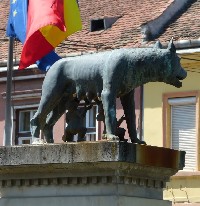Curtea de Argeș
| Curtea de Argeș population 27,360 is on the right bank of the Argeş River, where it flows through a valley of the lower Carpathians (the Făgăraș Mountains). One of the oldest towns in Wallachia, in the 13th century Curtea de Argeș was the capital of a small local state which was the start of the unification of the lands south of the Carpathians. Wikipedia |
Curtea de Arges is a small, fairly ordinary, town but has several historical sites in town and in the vicinity.
Curtea de Arges
Chief among these is the Argeș Monastery but in the town itself there is an even older historic church, the 14th century San Nicoara Church, set in the grounds of the now ruined Royal Court, dating from the 13th century.
It's now a somewhat nondescript field in which two cellars of the Court are preserved. And what's more, the Court was once inhabited by - you guessed - Vlad III, the Impaler (Vlad Dracula) who was Voivode (or prince) of Wallachia, of which Curtea de Arges was the principal city on three occasions in the fifteenth century.
And you thought we had seen the last of Dracula.
But no, a little way out of town on a canyon formed by the Argeș River valley is Poenari Castle or Citadel a fort associated with Vlad. Access to the citadel is made by climbing 1,480 stairs linked by upwards sloping pathways. At the top are some implements of torture and some figures impaled on tall spikes in the manner of Vlad, when fighting off the Muslims in Christ's name.
It was here that, as a result of tingling fingers, I first became aware that I might have a problem with my heart. It's fortunate that I took a couple of rest stops on the way to the top, in spite of my pride, because it's very isolated and forested with no obvious way that emergency services could access it quickly.
Amusingly it wasn't the only dice with death. Our TomTom GPS initially took us to a spot on the valley road, 400 metres vertically below the Citadel. After realising the error I drove on but could find nowhere wide enough to make a u-turn. I eventually had to make a very quick three-point turn instead on the narrow, tightly winding, road then back-track many kilometres to the footpath entrance we had already passed. It was of course clearly marked - in Romanian. The danger was Romanian drivers who are not notable for their caution or compliance with speed limits, as little shrines on the roadside attest.
Just as well we'd been to the Monastery for some vicarious soul-cleansing earlier that day!
The Argeș Monastery attracts most tourist interest and is reached by a one-way avenue of hundred year old linden trees trees, now bizarrely interspersed with supermarkets hotels and restaurants to cater for visitors, including the ubiquitous Irish Pub.
It's a thriving religious community with new buildings underway. In the grounds of the large Monastery is the spectacularly beautiful Romanian Orthodox Cathedral of Curtea de Argeș in which Kings Ferdinand and Carol I and Queens Marie of Romania; Elisabeth of Wied; and Anne of Romania are buried.
The present church was dedicated in 1886 replaces an earlier one. It had attracted a handful of tourists but was largely vacant of worshippers and seems to lack religious significance.
The nearby the Monastery building had attracted the many faithful, who move from one icon to the next in private religious observance in a way quite different to western Christian tradition. Interesting.
We had booked a B&B that although clean with a good breakfast, was close to a noisy road and well away from the centre. The promotional material claimed it was walking distance to points of interest - if you had several hours for walking past petrol stations furniture stores and shabby suburbia. As a result we had trouble finding it and when at last we did there was limited access and the woman who greeted us directed me to get closer and closer to some trees and to her garage door. Under her instructions I touched it with my bumper marking an overrider and making me cross, after driving all this way without a scratch. Fortunately a bit of spit and polish fixed the bumper. Anyway, Wendy gave them a bad Trip Adviser review and the woman got upset, claiming I'd damaged her door.
After Curtea de Arges we returned to Bucharest and briefly to the Grand Boutique Hotel, where the car was to be returned. Again they were again most accommodating, even though we were not staying the night, and organised our later trip to the airport. Unlike the B&B in Curtea de Argeș, this hotel is a definite recommendation if you ever want a nice place to stay in Bucharest.
More Images
Follow this link to see the full Romanian Album: Click Here...

